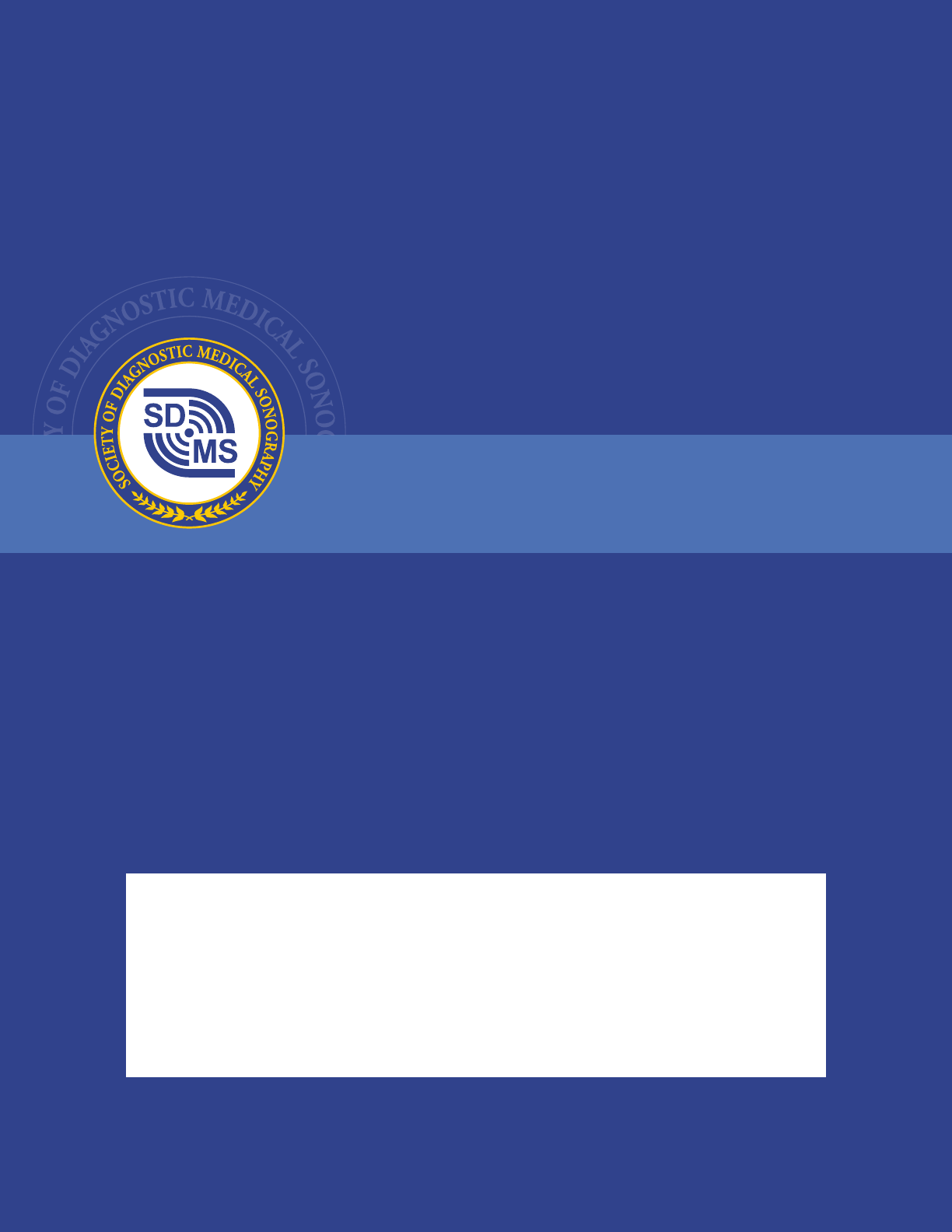
SOCIETY OF DIAGNOSTIC MEDICAL SONOGRAPHY
Journal of Diagnostic Medical Sonography
Author's Manual
Effective December 2020

JDMS Author Manual Page 2
TABLE OF CONTENTS
I. Journal Information ............................................................................................................................. 4
About the JDMS ................................................................................................................................. 4
Scope ................................................................................................................................................. 4
Mission ............................................................................................................................................... 4
Vision ................................................................................................................................................. 4
Commitment to Diversity, Equity, and Inclusion (DEI) ......................................................................... 4
Journal Indexing and Circulation ........................................................................................................ 5
Copyright, Authorization and Acknowledgement ................................................................................ 5
Research Ethics and HIPAA Privacy Standards ................................................................................. 6
Generative AI ..................................................................................................................................... 6
Peer Review ....................................................................................................................................... 7
Author Resources .............................................................................................................................. 8
II. Content of the JDMS ......................................................................................................................... 8
Original Research .............................................................................................................................. 8
Literature Reviews ........................................................................................................................... 10
Case Study or case series ............................................................................................................... 10
Symposia ......................................................................................................................................... 11
Editorials and Letters to the Editor .................................................................................................... 12
III. Manuscript Preparation and Submission ......................................................................................... 12
Reviewing the Literature ................................................................................................................... 12
Preparing the Manuscript ................................................................................................................. 13
JDMS Style ...................................................................................................................................... 14
Figures and Tables .......................................................................................................................... 15
Supplemental Audio/Video Files ....................................................................................................... 16
IV. Peer Review Timeline and Acceptance .......................................................................................... 16
JDMS Author Manual Page 3
V. Author Responsibilities and Rights .................................................................................................. 17
VI. JDMS CME Credit Policy ................................................................................................................ 17
Appendix A: Guide for New Authors..................................................................................................... 18
Appendix B: Guidelines for Student Submissions ................................................................................ 29
JDMS Editor-in-Chief
Society of Diagnostic Medical Sonography
2745 Dallas Pkwy Ste 350
Plano, TX 75093-8730
jdms@sdms.org
© Copyright, Journal of Diagnostic Medical Sonography

JDMS Author Manual Page 4
I. JOURNAL INFORMATION
ABOUT THE JDMS
Creating and interpreting clear and precise sonographic images is both an art and a science. The
Journal of Diagnostic Medical Sonography (JDMS) which is the official journal of the Society of
Diagnostic Medical Sonography, provides peer-reviewed innovative publications in all specialties
including but not limited to abdominal, women’s health, pediatric, cardiovascular, musculoskeletal, and
in all fields where new applications for ultrasound are being explored.
The JDMS is published bimonthly for diagnostic medical sonographers, students, educators, and other
ultrasound users who are seeking more information about the newest ultrasound technologies, and
latest ultrasound techniques, interpretation methods, and research applications.
The JDMS is a member of the Committee on Publication Ethics (COPE).
SCOPE
The Journal of Diagnostic Medical Sonography (JDMS) is the only peer-reviewed journal written for
diagnostic medical sonographers and other ultrasound users across all specialties. The Journal
explores the use of ultrasound technology to enhance diagnosis, intervention, and other clinical
applications. It does this through the publication of original research findings, evidence-based scientific
information related to clinical practice, and the identification of emerging technology in the field of
diagnostic medical sonography.
MISSION
The JDMS is dedicated to publishing evidence-based research and clinical best practices for the
sonography and medical communities.
VISION
The JDMS will be the leading educational and scientific resource for advancing the use of
ultrasound in sonography clinical practice, education, and research.
COMMITMENT TO DIVERSITY, EQUITY, AND INCLUSION (DEI)
The SDMS, including the JDMS, is committed to ensuring promoting and implementing ongoing
improvements to diversity, equity, and inclusion in the diagnostic medical sonography profession and in
its membership, leadership, volunteers, and staff. The SDMS Board of Directors recognizes the
success of the SDMS’ mission depends on members, leaders, volunteers, and staff who provide
diverse backgrounds, experiences, and opinions, without regard to the characteristics outlined below.
There shall be no barriers to full participation in the SDMS based on race, ethnicity, skin color, national
origin, citizenship, language, ancestry, age, sex, gender identity or expression, sexual orientation,

JDMS Author Manual Page 5
mental or physical (dis)ability, religion or religious commitment, marital status, medical condition or
status, pregnancy status, socioeconomic status, veteran status, political perspective, geographic
location, or any characteristic protected by federal, state, or local law.
In addition, the SDMS supports and encourages its members, the sonography profession, and the
medical community to support efforts to:
• Improve patient care by reducing health disparities; and
• Ensure diversity, equity, and inclusion in sonography educational, employment, and career and
professional development opportunities.
SDMS Board Policy: Diversity, Equity, and Inclusion. Adopted by the SDMS Board of Directors, December 2, 2020.
JOURNAL INDEXING AND CIRCULATION
The JDMS is currently indexed with CINAHL, the Emerging Sources Citation Index (ESCI),
EMBASE/Excerpt Medica, InfoTrac (full text), and Scopus. It has a total circulation of over 35,000
subscribers.
COPYRIGHT, AUTHORIZATION AND ACKNOWLEDGEMENT
The SDMS owns the copyright on all material published in the JDMS and authors must sign a transfer
of copyright statement prior to publication. The Editor provides a transfer of copyright form to the
corresponding author when the manuscript review is complete. Forms may also be obtained by
contacting the JDMS office at jdms@sdms.org.
As part of the submission process you will be required to warrant that you are submitting your original
work, that you have the rights in the work, and that you have obtained and can supply all necessary
permissions for the reproduction of any copyright works not owned by you, that you are submitting the
work for first publication in the Journal and that it is not being considered for publication elsewhere and
has not already been published elsewhere.
A list of all Sage Policies can be found online.
Sage and the JDMS take plagiarism and image integrity very seriously. Submitted articles may be
checked with duplication-checking software. Where an article is found to have plagiarized other work or
included third-party copyrighted material without permission or with insufficient acknowledgement, or
where the authorship of the article is contested, we reserve the right to take action including, but not
limited to: publishing an erratum or corrigendum (correction); retracting the article; taking up the matter
with the head of department or dean of the author's institution and/or relevant academic bodies or
societies; or taking appropriate legal action.
The International Committee of Medical Journal Editors defines the role of authors and contributors. All
contributors who do not meet the criteria for authorship, including professional writing assistance or
technical help, should be listed in the Acknowledgements section. Funding sources should also be
acknowledged. A ‘Declaration of Conflicting Interests’ statement should also be included at the end of
your manuscript, or you may state that ‘The Author(s) declare(s) that there is no conflict of interest’.

JDMS Author Manual Page 6
If material has been previously published it is not generally acceptable for publication in a Sage journal.
However, there are certain circumstances where previously published material can be considered for
publication. Please refer to the guidance on the Sage Author Gateway or if in doubt, contact the Editor.
For previously published figures or other information, the author must obtain a written release from the
original copyright holder. The permission should be uploaded as a permissions file in the manuscript
submission system. A standard Request for Permission to Reprint is available on the SDMS website.
RESEARCH ETHICS AND HIPAA PRIVACY STANDARDS
Medical research involving human subjects must be conducted according to the World Medical
Association Declaration of Helsinki. In addition, submitted manuscripts should conform to the ICMJE
Recommendations for the Conduct, Reporting, Editing, and Publication of Scholarly Work in Medical
Journals, with all papers reporting animal and/or human studies stating in the methods section that the
relevant Ethics Committee or Institutional Review Board provided (or waived) approval. Please ensure
that you have provided the full name and institution of the review committee, in addition to the approval
number. For research articles, authors are also required to state in the methods section whether
participants provided informed consent and whether the consent was written or verbal.
Please also refer to the ICMJE Recommendations for the Protection of Research Participants.
All healthcare researchers must be familiar with the HIPAA privacy rule and its implications for
recruitment of human subjects, protection of personal health information, and disclosure of scientific
results. Regardless of specific IRB processes, it is necessary for all researchers to obtain written
HIPAA authorization before publishing papers or making presentations containing Personal Health
Information (PHI).
A full summary of the rule is located on the US Department of Health and Human Services site.
Any research results containing patient-level data should be reviewed to ensure that the eighteen
HIPAA identifiers have been removed, and whether the information being published could be combined
with other publicly-available information to reveal the identity of a participant. Materials involving
photographs, rare diseases, or highly publicized cases should be reviewed with particular care. In
general, it is best to include the minimum amount of patient-specific information that is possible while
still conveying details relevant to the findings, and to be broad in reporting (e.g., female in late twenties
as opposed to 28-year-old female).
GENERATIVE AI
Sage recognizes the value of large language models (LLMs) (e.g., ChatGPT) and generative AI as
productivity tools that can help authors in preparing their article for submission; to generate initial ideas
for a structure, for example, or when summarizing, paraphrasing, language polishing etc. However, it is
important to note that all language models have limitations and are unable to replicate human creative
and critical thinking. Human intervention with these tools is essential to ensure that content presented is
accurate and appropriate to the reader.

JDMS Author Manual Page 7
Authors are required to:
• Clearly indicate the use of language models in the manuscript, including which model was used
and for what purpose. Please use the methods or acknowledgements section, as appropriate.
• Verify the accuracy, validity, and appropriateness of the content and any citations generated by
language models and correct any errors or inconsistencies.
• Provide a list of sources used to generate content and citations, including those generated by
language models. Double-check citations to ensure they are accurate and are properly
referenced.
• Be conscious of the potential for plagiarism where the LLM may have reproduced substantial
text from other sources. Check the original sources to be sure you are not plagiarizing someone
else’s work.
• Acknowledge the limitations of language models in the manuscript, including the potential for
bias, errors, and gaps in knowledge.
• Please note that AI bots such as ChatGPT should not be listed as an author on your
submission.
The full policy on Generative AI can be found on Sage’s website.
PEER REVIEW
The JDMS follows a scholarly, double-blinded peer review process. The Editor or members of the
Editorial Board may occasionally submit their own manuscripts for possible publication in the journal. In
these cases, the peer review process will be managed by alternative members of the Board and the
submitting Editor/Board member will have no involvement in the decision-making process and an
appropriate ethical statement/disclosure will be included for publication.
Manuscripts are accepted for consideration on the condition that they are contributed solely to the
JDMS. No substantial part of a paper (except for a scientific abstract or poster) may have been
published elsewhere. All work must be original. Receipt of your manuscript by the journal will be
acknowledged and a decision regarding its status made as soon as possible. All manuscripts are
subject to editorial review. Manuscripts will be initially reviewed by the Editor-in-Chief. Some
manuscripts that are deemed inappropriate for the journal or very low priority by the editorial staff may
be returned without review. If eligible for publication, the manuscript will be reviewed by an Associate
Editor and two or more external, independent reviewers. Revisions, if requested, will require
resubmission within 90 days, unless otherwise specified. Manuscripts must be written in acceptable
English. Manuscripts submitted in poor English may be returned without review (see “English Language
Editing Services” section below).
Information on the process for contesting editorial and peer review decisions can be found on the Sage
website.

JDMS Author Manual Page 8
AUTHOR RESOURCES
SAGE EDUCATION
A free online course on How to Get Published is available from Sage.
ENGLISH LANGUAGE EDITING SERVICES
Authors seeking assistance with English language editing, translation, or figure and manuscript
formatting to fit the journal’s specifications should consider using Sage Language Services. Visit Sage
Language Services on our Journal Author Gateway for further information.
ARTICLE PROMOTION
Publication is not the end of the process! You can help disseminate your paper and ensure it is as
widely read and cited as possible. The Sage Author Gateway has numerous resources to help you
promote your work. Visit the Promote Your Article page on the Gateway for tips and advice, or learn
how to proactively Help Readers Find Your Article through search engines.
Also available for reference:
• 5 Features of a Highly Cited Article
• Promoting your Paper (video)
In addition, you can maximize your article’s impact with Kudos, a free service that allows authors to
explain, enrich, share, and measure the impact of their article.
II. CONTENT OF THE JDMS
The composition of JDMS continuously evolves to reflect development in the field of sonography and
the needs of the readership.
ORIGINAL RESEARCH
An original research project is an extensive project that uses scientific methods to support the findings.
The project begins by asking a research question or stating a hypothesis. Subjects may include critical
reviews of current research or clinical practice, descriptions of pathology or medical progress, analysis
of sonography education, social science of health behaviors, current technology, healthcare
management, and others.
A typical Original Research manuscript must include the following sections within the Main Document in
the following order:
I. Structured Abstract (Objective, Materials & Methods, Results, Conclusion)
II. Keywords (MeSH terms preferred)
III. Introduction (concise review of existing literature, objective, and research question)
IV. Materials & Methods (including inclusion/exclusion criteria, statistical and power analyses)

JDMS Author Manual Page 9
V. Results (including descriptive data and inferential data analysis)
VI. Discussion (compare/contrast results with literature, to what degree was research question
answered)
VII. Limitations
VIII. Conclusion (what was uncovered, and how it impacts the journal audience)
IX. Ethical Statements
X. Key Takeaways (3-4 most important implications for clinical practice)
XI. At least 10 peer-reviewed, scientific references in AMA format
An ethical statement is required to ensure full disclosure of the research and review process. The
following statements must be included in your Original Research manuscript submission:
• Ethics Approval (choose one as appropriate):
o Ethical approval for this study was obtained from *NAME OF ETHICS COMMITTEE OR
INSTITUTIONAL REVIEW BOARD (APPROVAL NUMBER/ID)*.
o Ethical approval for this study was waived by *NAME OF ETHICS COMMITTEE OR
INSTITUTIONAL REVIEW BOARD* because *REASON FOR WAIVER*.
o Ethical approval was not sought for the present study because *REASON*.
• Informed Consent (choose one as appropriate):
o Written informed consent was obtained from all subjects before the study.
o Verbal informed consent was obtained from all subjects before the study.
o Written informed consent was obtained from legally authorized representatives before
the study.
o Verbal informed consent was obtained from legally authorized representatives before the
study.
o Informed consent was not sought for the present study because all case data was de-
identified and/or aggregated and followed ethics committee or IRB guidelines (also
referred to as the Honest Broker System).
• Animal Welfare (choose one as appropriate):
o The present study followed international, national, and/or institutional guidelines for
humane animal treatment and complied with relevant legislation.
o The present study involved client-owned animals; it demonstrated a high standard (best
practice) of veterinary care and involved informed client consent.
o Guidelines for humane animal treatment did not apply to the present study because
*REASON*.
• Trial Registration (choose one as appropriate):
o *NAME OF TRIAL REGISTRY: TRIAL REGISTRATION NUMBER*
o This randomized controlled trial was not registered because *REASON*.
o Not applicable.
• Declaration of Conflicting Interests (choose one as appropriate):
o *LIST OF POTENTIAL CONFLICTS OF INTEREST FOR ALL AUTHORS*.
o The author(s) declare(s) that there are no conflicts of interest with respect to the
research, authorship, and/or publication of the article.
• Funding (choose one as appropriate):
o *LIST OF FUNDING INFORMATION*.
o The author(s) received no financial support for the research, authorship, and/or
publication of this article.

JDMS Author Manual Page 10
Original Research manuscripts should have a main body of at least 1,500 words.
LITERATURE REVIEWS
A literature review article summarizes the pertinent research findings that have been reported in
textbooks and journal articles. A systematic process needs to evident as to how the literature was
pulled (ex. Keywords, term, etc.) as well as the databases used to locate the literature used as part of
the review. It provides a basic description of the topic being reviewed as well as current findings and
theories. The value of a literature review article is its synthesis of the most current information.
A typical Literature Review manuscript must include the following sections within the Main Document in
the following order:
I. Structured Abstract (Objective, Materials & Methods, Results, Conclusion)
II. Keywords (MeSH terms preferred)
III. Introduction (concise review of existing literature, objective, and research question)
IV. Materials & Methods (how did you search, number of results, vetting process, degree of rigor)
V. Results (including table with articles reviewed, author(s), year, summary of main point)
VI. Discussion (compare/contrast research, explain conclusions from comparison, and identify
limitations, methodological problems, or gaps)
VII. Conclusion (what was uncovered, and recommendations for future research)
VIII. Key Takeaways (3-4 most important implications for clinical practice)
IX. At least 10 peer-reviewed, scientific references in AMA format
Literature Review manuscripts should have a main body of at least 1,500 words.
CASE STUDY OR CASE SERIES
Written accounts of the impact of sonography on patients with rare pathology, or unusual combinations
of pathology are popular contributions to the JDMS. A case which includes excellent examples of
normal anatomy, or the first reported visualization of normal anatomic structures, or the use of new
technology may also be reported. Sonograms that clearly demonstrate the sonographic findings are
included, as well as an account of the patient's symptoms, other diagnostic findings, treatment,
prognosis, and a brief discussion of the disease. Most case studies should provide a comparison of the
reported case to those that have been reported previously or to other modalities. The inclusion of a
comparison of the current case to those that
A typical Case Study manuscript must include the following sections within the Main Document in the
following order:
I. Unstructured Abstract
II. Keywords (MeSH terms preferred)
III. Introduction (pathology, incidence/prevalence or other facts, patient clinical history/symptoms)
IV. Case Report or Case Series (lab results, other imaging, sonographic findings, procedures,
outcome)

JDMS Author Manual Page 11
V. Discussion (normal vs. pathology, clinical signs/symptoms, disease progression,
treatments/outcomes, prognosis, value of sonography vs. other imaging methods)
VI. Conclusion (what was uncovered, and recommendations for future research)
VII. Ethical Statements
VIII. Maximum of 8 references in AMA format
An ethical statement is required to ensure full disclosure of the research and review process. The
following statements must be included in your Case Study or Case Series manuscript submission:
• Ethics Approval (choose one as appropriate):
o Ethical approval for this study was obtained from *NAME OF ETHICS COMMITTEE OR
INSTITUTIONAL REVIEW BOARD (APPROVAL NUMBER/ID)*.
o Ethical approval for this study was waived by *NAME OF ETHICS COMMITTEE OR
INSTITUTIONAL REVIEW BOARD* because *REASON FOR WAIVER*.
o Ethical approval was not sought for the present study because *REASON*.
• Informed Consent (choose one as appropriate):
o Written informed consent was obtained from all subjects before the study.
o Verbal informed consent was obtained from all subjects before the study.
o Written informed consent was obtained from legally authorized representatives before
the study.
o Verbal informed consent was obtained from legally authorized representatives before the
study.
o Informed consent was not sought for the present study because all case data was de-
identified and/or aggregated and followed ethics committee or IRB guidelines (also
referred to as the Honest Broker System).
• Declaration of Conflicting Interests (choose one as appropriate):
o *LIST OF POTENTIAL CONFLICTS OF INTEREST FOR ALL AUTHORS*.
o The author(s) declare(s) that there are no conflicts of interest with respect to the
research, authorship, and/or publication of the article.
• Funding (choose one as appropriate):
o *LIST OF FUNDING INFORMATION*.
o The author(s) received no financial support for the research, authorship, and/or
publication of this article.
A Case Study should be a minimum of 750 words and typically do not contain tables or data sets.
SYMPOSIA
A symposia typically falls under topics such as “Energizing Education,” “Professional Issues”, “Policy”,
and “Advances in Technology”. Symposia should be focused on novel approaches to teaching,
universal issues influencing the profession, the impact of policy changes, or advancements in
ultrasound technology. Additional scholarly content of interest to the profession may be considered.
Manuscripts may be Editor or peer-reviewed for relevance, accuracy, and timeliness. These
submissions may originate through SageTrack and go through the peer review process or be uploaded
directly to SMART.
A typical Symposia manuscript must include the following sections within the Main Document in the
following order:

JDMS Author Manual Page 12
IX. Unstructured Abstract
X. Keywords (MeSH terms preferred)
XI. Conclusion (what was uncovered, and recommendations for future research)
XII. Ethical Statements
XIII. Between 10 to 12 references in AMA format
An ethical statement is required to ensure full disclosure of the research and review process. The
following statements must be included in your Symposia manuscript submission:
• Declaration of Conflicting Interests (choose one as appropriate):
o *LIST OF POTENTIAL CONFLICTS OF INTEREST FOR ALL AUTHORS*.
o The author(s) declare(s) that there are no conflicts of interest with respect to the
research, authorship, and/or publication of the article.
• Funding (choose one as appropriate):
o *LIST OF FUNDING INFORMATION*.
o The author(s) received no financial support for the research, authorship, and/or
publication of this article.
Symposia manuscripts should have a main body of at least 2,500 words.
EDITORIALS AND LETTERS TO THE EDITOR
Editorials and Guest Editorials are written by a JDMS Editor or invited guest and express an idea
that is thought provoking and relevant to JDMS readers. The Editor-in-Chief may request an editorial, or
sonographers or physicians who want to make readers aware of an observation, idea, or trend may
submit an unsolicited editorial. This manuscript is generally solicited by the Editor-in-Chief and one is
included in each issue. SDMS staff review content for publication once reviewed by the Editor-in-Chief.
Letters to the Editor may be submitted by readers wishing to respond to articles appearing in the
journal. They are published at the Editor’s discretion and edited for style.
III. MANUSCRIPT PREPARATION AND SUBMISSION
The JDMS utilizes Sage’s manuscript submission system, SageTrack (powered by ScholarOne), for
electronic manuscript submission. Definitions below are provided for guidance. Sage also offers an
online Journal Author Gateway with additional tips and information.
REVIEWING THE LITERATURE
A complete review of existing literature should be performed prior to preparing any manuscript for the
JDMS. Suggested search engines include:
• Google Scholar
• Scopus
• Web of Science
• PubMed
• EBSCO / CINAHL

JDMS Author Manual Page 13
• ERIC
• ScienceDirect
The keywords that you choose to search on will have a big bearing on your results! If this is your first
time searching for scholarly literature, you may wish to ask for assistance from your institutional
librarian, review online university resources, or solicit help from others within your network.
PREPARING THE MANUSCRIPT
The manuscript should be prepared using Microsoft Word and uploaded digitally through SageTrack.
The manuscript submission process will require multiple separate files:
1. Title page, which should include:
a. Title of the paper
b. Names of all authors and their hospital or work affiliation(s)
c. Address for correspondence, phone number, and email addresses for all authors
d. Acknowledgements (if appropriate)
2. Main document, which should not include any identifying author or sponsor information
a. Abstract (approximately 150 words, structured for Original Research and Literature
Review manuscripts and unstructured for Case Study or Case Series)
b. Three to five keywords
c. Main body of less than 1,000 words for Case Study or Case Series and at least 1,500+
words for Original Research or Literature Review, which conform to AMA Style (11
th
edition - see above for required sections based on manuscript type)
d. References
i. Appropriate number based on article type in AMA format, numbered
consecutively and all cited within the text
ii. Should be recent, relevant, and peer-reviewed (see pages 22 and 26 of this
document for additional guidance)
e. All tables, summarized and in editable format (if included)
f. Legends for all images, videos, tables and figures, each of which should be called out
within the text (including online-only videos and supplemental material)
g. Key Takeaways callout box (bulleted list of top 3-4 takeaways for clinical practice) for
Original Research and Literature Review manuscripts
3. Images, Figures and Videos, including any required arrows or labels, uploaded in digital format
and with captions for each (more details on the Sage website under Preparing Your Manuscript).
Rasterized based files (i.e. with .tiff or .jpeg extension) require a resolution of at least 300 dpi
(dots per inch). Line art should be supplied with a minimum resolution of 800 dpi.
4. Written permission to use previously published figures, tables, or text if required
The main paper should be typed double-spaced using Microsoft Word, with all pages numbered. Each
page of the main document should be numbered. PDF file format is not accepted for peer review.
A Contributor Form will be required of the corresponding author later in the process and will be sent by
email after manuscript acceptance.

JDMS Author Manual Page 14
CHECKLISTS AND GUIDELINES FOR MANUSCRIPTS
When preparing a manuscript for submission, it's beneficial to adhere to a set of guidelines and
checklists. These checklists serve as a roadmap to ensure the manuscript meets the necessary
standards and reporting requirements in your study affirming its compliance with established research
practices. The applicable checklist will be required to be uploaded alongside your manuscript
submission.
• CARE Checklist; utilized for Case Studies
• CHERRIES Checklist; utilized for Survey Research
• CONSORT Checklist; utilized for Clinical Trials
• PRISMA Checklist; utilized for Literature Reviews
JDMS STYLE
JDMS follows the American Medical Association (AMA) Manual of Style. The following style points can
serve as a general guide.
1. Most common prefixes and common suffixes should be joined without a hyphen. (Example:
postembryonic, intrapelvic, preoperative)
2. Abbreviated terms should be spelled out the first time they are used. Latin terms such as e.g.,
i.e., et al., and etc. should be abbreviated with periods and set in Roman type.
3. Follow recommended style for abbreviations of units of measure, with the exception of liters,
Gauss, and Tesla. (Liters should be spelled out in text except when used in virgule
constructions.) Common examples: C, cc, cm, g, kHz, MHz, mm, mmHg.
4. Omit the suffix "-al" in adjectives unless its absence changes the meaning of the word.
(Example: acoustic, anatomic, neurologic, obstetric, theoretic)
5. Spell out and italicize genus and species at first mention (Example: Escherichia coli,
Treponema pallidum). After the first mention, abbreviate genus name without a period
(Example: E coli, T pallidum).
6. Spell out all numbers from one through ten and use Arabic numbers for all numbers greater
than ten, with two exceptions: if any number in a category is greater than ten, all units in that
category should be in Arabic numbers. Units of measure always appear in Arabic numbers.
7. Spell out all units of time (Example: seconds, minutes, hours) except in virgule constructions.
8. Avoid "sexist" classifications; use of “they” rather he/she is preferred.
Certain terms that are specific to diagnostic ultrasound are not addressed in the AMA Manual of Style;
therefore, we have adopted formats common to practice and literature. These terms are listed below:
bandwidth - Close up space between words.
B-mode and M-mode echocardiography - Hyphenate and use capitalization as shown here.
conceptuses - The plural form should be spelled in this way.
disk - Preferable to disc.

JDMS Author Manual Page 15
Doppler - Capitalize as shown.
examination - Spell out the full word in text.
Gauss - Spell out this unit of measure.
gravida 2, para 1 - Abbreviate these terms and use Arabic numbers as shown.
gray-scale - Hyphenate as shown.
linear-array - Hyphenate as shown.
real-time - Hyphenate as shown.
Sonographers - Preferable to technologists, technicians, or ultrasonographers.
Sonography - refers to imaging. Preferable to diagnostic ultrasonography or diagnostic
ultrasound.
Tesla - Spell out this unit of measure.
2D - Two-dimensional should be abbreviated with the Arabic number and a capital letter.
waveform - Close up space between words.
x-ray - Hyphenate as shown.
FIGURES AND TABLES
Figures and illustrations will be accepted in one of two formats:
1. Embedded within the Main Document, including captions, on the same page where referenced;
2. Uploaded as separate figure files, named in the same manner (i.e. Figure 1, Figure 2, etc.) as
referenced in the text with captions included.
During the upload process authors will be asked to include appropriate figures and tables, if applicable,
that are typically labeled numerically as Figure 1, Figure 2, etc. and cited in numerical order in the text.
The general term “Figure” may be used throughout the manuscript if a variety of illustration types are
used, such as tables, diagrams, images, etc.
Figures should be professionally drawn or photographed; freehand or type-written lettering will not be
accepted. Sonograms, x-rays, and other images should be of diagnostic quality and structures should
be labeled clearly with arrows or letters explained in the legend. Personal information (i.e. patient
name, medical record number, date, location, hospital number) must be cropped from the
figure. It is the responsibility of the author to add arrows, labels, and delete personal information.
Arrows and labels must be added to the original image file prior to embedding in the Word document.
Each figure and/or table must have a caption that provides enough information to allow the item to be
clearly identified. Captions should be a complete set of sentences that describe the figure and or table.
Tables should be used to summarize data and should be cited in numerical order in the text. Tables
should be typed (editable) and provided together at the end of the Main Document. For borrowed tables,
the author must obtain permission from the copyright holder. In a footnote to the table, the author
should cite authors, article, journal, etc., as in references or indicate reference number if cited in a
reference list. If material for a table is modified or adapted, no permission is required, but the source
should nevertheless be cited in a footnote to the table.

JDMS Author Manual Page 16
Legend information should be summarized onto a single page and uploaded as part of the main
document, as well as input for each figure during file upload in the SageTrack system.
SUPPLEMENTAL AUDIO/VIDEO FILES
Audio or video files may be uploaded with the submission to support the evidence outlined in the
manuscript or provide supplemental material to the reader. Audio/video file types include .MOV, .MP4,
and .MPEG. Video files should be of reasonable time length. While there is no size limit, when the size
of a single file is bigger than 10MB, some users may experience problems when downloading.
Free or native tools for video editing such as iMovie, PowerPoint, etc. should be used to edit for size,
length, and to remove any identifying patient information before the video is submitted.
All supplemental material and video files should be called out/referenced within the manuscript.
When uploading supplemental videos through the SageTrack website, select the Supplementary File
type, and append ‘supplemental_video’ to the filename and number based on order of viewing.
IV. PEER REVIEW TIMELINE AND ACCEPTANCE
After the manuscript is submitted, the Editor-in-Chief will acknowledge receipt and the manuscript will
begin the peer review process in accordance with the following approximate timeline:
I. Within 1 week - an initial review is conducted for relevance to the JDMS and manuscript
quality. At this stage, a manuscript may be accepted for peer review, rejected, or
unsubmitted pending missing information or required changes to meet JDMS guidelines.
II. Within 6-10 weeks – once the manuscript is accepted for peer review and all required
components are received, it is assigned to the Editor-in-Chief or Associate Editor to be
managed through the peer review process. At least three peer reviewers who are experts in
the field review each manuscript and provide feedback, which is then relayed to the
author(s) along with a decision of Accept, Minor Revisions Needed, Major Revisions
Needed, or Reject.
III. If revisions are required, submitted changes are reviewed within 4-6 weeks.
IV. Once the manuscript is accepted and the contributor form is received, the article is
submitted to the publisher for copyediting and available online within 3-4 weeks. It is
typically included within the next available print issue unless it is held to be included in a
dedicated issue on a relevant clinical topic.
Upon OnlineFirst and issue publication, the corresponding author will receive an e-access link to the
article to share with their co-authors. The e-access link allows all authors to access the published article
free of charge. Once the article is published in an issue, authors can contact the Sage customer service
team at journals@sagepub.com for a discount rate on the single print issue price. Additional details can
be found on the Sage website.

JDMS Author Manual Page 17
V. AUTHOR RESPONSIBILITIES AND RIGHTS
Please refer to the Ethics & Responsibility section of our Journal Gateway for up-to-date information on
publication ethics and on Sage’s publishing policies.
For a reminder of the rights authors retain in their articles and Sage’s, please visit the Copyright and
Permissions section of our Journal Gateway.
VI. JDMS CME CREDIT POLICY
Published authors may be eligible to receive SDMS CME credit once an accepted manuscript is slated
to be published in a JDMS issue.
JDMS Authors will automatically receive SDMS CME credits as determined by the number of authors
list on the published article. If a published article has only one author listed, the single author with
receive 4 SDMS CME credits. If more than one author is listed on a published article, each author will
receive 2 SDMS CME credits.
Authors do not receive SDMS CME credit for articles not accepted for publication. All SDMS CME
credits are granted to authors on published manuscripts who are SDMS members at the time CME
credits are awarded. SDMS CME credit is not available to non-SDMS members. SDMS CME credits
are issued through the SDMS CME Tracker if the author is a current SDMS member.
The SDMS does not award CME credit for published editorials, symposia, or letters to the Editor.
All SDMS CME credits are granted to authors on published manuscripts who are SDMS members at
the time CME credits are awarded. SDMS CME credit is not available to non-SDMS members.

JDMS Author Manual Page 18
APPENDIX A: GUIDE FOR NEW AUTHORS
GETTING STARTED
Writing is a learned skill. Even the best writers require continuous work to refine their skills and profit
from the peer review process. The more you practice writing, the more skill you will develop. The first,
most important step, to writing is first having the desire to convey a message to the reader.
One way to become a better writer is to become a better reader. In reading medical literature, you can
gain insight on how scientific articles are constructed. You will notice that each type of article has
consistent elements, and more importantly, you will become familiar with the language used in scientific
writing. In addition to improving your writing, reviewing current literature will generate ideas for your
projects. This exercise can help you find the gaps in the current knowledge which can spark new ideas for your
writing. As you review the current literature, be sure to maintain the bibliographic information because
you will need it later when you complete the reference page of your manuscript.
There are many hints on how to begin writing for those who are intimidated by it. Oftentimes, people
who do not like to write do well at expressing themselves orally. In this case, you can pretend you are
discussing the topic with a friend and record the conversation. This will provide a framework from which
to write a paper. Another approach that works with some people is to write down every thought relating
to the topic, in a stream of consciousness. Then after letting the list sit for a day or two, go back and
delete items that are irrelevant. The remaining items can then be organized into an outline for a paper.
Writing from a detailed outline is a key component of an organized manuscript.
You may have noticed common themes in your literature survey, and those themes may become your
section headings. Section headings are all ideas or themes that will support your message, and the
number of headings that you have will depend on the topic, how deeply you wish to explore it, and how
much literature you have to support it. In some cases, writing the conclusion first is helpful, because it
summarizes the idea you wish to communicate. By knowing how you want your paper to end, you may
have a clearer idea of what you should write in the body of the paper to prove your conclusion.
Overcoming the fear of writing also involves dealing with the fear of rejection. To assist in this, feedback
is provided to all authors, regardless of previous history of writing or the Journal. The feedback helps
them prepare the current manuscript for publication and to gain knowledge for future submissions.
Reviewers and editors do not wish to reject articles, and would much rather ask for major revisions that
will allow the submission to be published in a later form. Authors may write to the JDMS Editor to
request that a mentor be assigned if they need assistance in making the recommended changes.
“Defeat is not the worst of failures. Not to have tried is the true failure."
-George Edward Woodberry (American literary critic and poet)

JDMS Author Manual Page 19
WRITING EFFECTIVELY
1. Organization and editing is the key to good writing. Begin with an outline that follows a logical
order. Suggested outlines for each manuscript type accepted by the JDMS can be found within
this document.
2. Make a sentence from each topic on the outline, keeping the main headings and subheadings
together in one paragraph. Headings should indicate when you are switching to a new main
topic.
3. In a research paper, write the paper before writing the abstract and title.
4. Writing tips:
a. Follow a logical progression in your paper.
b. Use simple words rather than complex ones. Omit adjectives and adverbs that are not
necessary, such as very, extremely, excessively, etc.
c. Paragraphs should contain a topic sentence and at least 2-5 additional sentences that
support the information.
d. Be aware of paragraphs (and sentences) that are excessively long or contain too many
ideas. Keep your sentences short and simple.
e. Maintain an active, consistent voice and tense throughout the paper and avoid using first
person. In scientific writing, the third person voice should be used.
f. Ensure that your subject and verbs agree as well as your nouns and pronouns.
g. Numbers that start sentences and ordinals should be spelled. Otherwise, you may use
the Arabic numbers to express numerical information (see JDMS Style).
h. Use correct sonographic terminology.
5. Be prepared to revise the paper as many times as necessary before submitting it, and at least
once after it is submitted for publication.
6. Have an uninvolved, yet knowledgeable, colleague read the paper to critique it and proof for
errors.
7. Consider your audience and write in a way that they can understand you.
Additional information on proper formatting can be found in the AMA Manual of Style.
CHOOSING THE APPROPRIATE ARTICLE TYPE
There are three main types of articles that the Journal of Diagnostic Medical Sonography publishes that
are a good place for a sonographer to start: Original Research, Literature Reviews, Case Study or
Case Series. Each type of manuscript has a unique format that you should follow.
ORIGINAL RESEARCH
An original research project is an extensive project that uses the scientific method to support the
findings. The project begins by asking a research question, or a hypothesis. Topics for original research
may stem from a trend you have noticed, and you want to learn if your observation is real, or just a
coincidence.
JDMS Author Manual Page 20
Then an experiment is designed to test the hypothesis, and data collection and subsequent data
analysis is used to determine if the question can be answered. A research project is extensive because
there is considerable pre-work that must be completed before an experiment can be conducted. If you
are not an experienced researcher, you should seek a project mentor who is familiar with the subject as
well as with the research process.
The most important thing to do before embarking on an original research project is to speak with your
institution’s research review board, sometimes called an institutional review board (IRB). You will most
likely have to submit an extensive proposal to a review board, which will require you to have your entire
project outlined from start to finish.
In preparation to submit your project to an institutional review board, you must determine the following:
1. Your hypothesis
a. Why is it an important question?
b. What gaps in knowledge does this project address?
c. What literature supports your need to research this hypothesis?
2. How you will test your hypothesis (consult with a statistician if appropriate)
a. How many subjects do you need for power of your study?
b. Informed consent for participation in research?
3. How you will collect your data?
a. Survey tool or data source
b. Form to write down measurements, if necessary
c. Image review
d. Medical records review
4. How you will analyze your data?
a. Statistical analysis
5. How will you monitor the safety of your data/ and your subjects?
Once an institutional review board approves your project, you may begin recruiting subjects and
perform your study. You should collect your data in the manner that you outlined in your application to
the institutional review board and take note of any problems that you encounter. Once you have
collected your data, you will need to enter it into a spreadsheet or a database (however your statistician
prefers) so that it can be analyzed with statistical analysis software. After you have your data analyzed
and you understand what conclusions can be drawn, it is time to write the paper.
A research paper follows a predictable pattern which includes (in the case of the JDMS) a structured
abstract, usually containing 150 words or less. The abstract is followed by an introduction of the topic
and any interesting facts that justify the importance of the topic. The next section is the background in
which you will summarize previous research related to the topic. In the background section, it is
important to identify the strengths and limitations of the previous research as well as identify the
unknown information that has yet to be addressed. The background section typically concludes with
your specific research question or hypothesis to be tested.
The methods section follows your background section. It includes your hypothesis and the power of the
study. In this section, you should outline each step of your experiment. It is important to detail the type

JDMS Author Manual Page 21
of equipment used and the quality control measures utilized to produce valid data. The methods section
should be written clearly and concisely so that someone else could easily replicate your study. The
results section follows methods, and in this section, you report the results. Depending on the amount of
data you analyzed, you may only want to report some of your results in writing. For the remainder of the
results that you do not wish to write about specifically, you can put them in a table and refer the reader
to that table.
The discussion section of the paper is the point at which you will provide the interpretation and
explanations of your results. You should state what you think your results mean within the limits of your
experimental design. In this section you should also identify the strengths or weaknesses of your study.
For example, you might explain how your study size compares to other studies, and whether the
demographics of your subjects are reflective of those in other studies. You alternately might explain if
there were limitations that mean your study is not generalizable to the larger population. Finally, you
should suggest future research projects that would expand on your results.
The conclusion should be short, and should summarize the problem, your findings, and the implications
of your results. After the conclusion, it is appropriate to include any information about funding, conflicts
of interest, or addressing individuals who have helped you with your project but who do not necessarily
meet the criteria for authorship. The reference page comes last. The JDMS uses the reference style
outlined in the American Medical Association Manual of Style: A Guide for Authors and Editors.
Once your paper effectively conveys the information, you should finalize the other required
components including the title page, the illustrations and figures and the figure legends, tables and any
appendices. The illustrations and figures must be professionally drawn or photographed and must meet
production quality requirements. Some journals, including the JDMS, require online submission, and
therefore, images and figures must be submitted in high quality .jpeg or .png or other listed format.
Original research manuscripts should be at least 1500 words and include at minimum ten scholarly,
peer-reviewed references. A general outline for original article papers includes:
1. Structured Abstract
a. Objective(s): The statement of the problem and or the research question driving the
study.
b. Materials & Methods: Concise details of the type of project and study design
c. Results: The salient descriptive and analytical data that are used the answer the
research question.
d. Conclusion: A statement (or two) about the relevance to the clinical practice of
sonography.
2. Introduction and background (interesting information about the topic, what makes it
important, summary based on literature of what is known so far and previous studies’
strengths and limitations, and the hypothesis or question being addressed)
3. Materials & Methods
a. Type of study (educational, diagnostic, descriptive, comparative, case/control)
b. Study design (interventional, case series, diagnostic sensitivity, cohort, etc)
4. Results
a.

JDMS Author Manual Page 22
5. Discussion
a. Explain conclusions that should be drawn from the study
b. Identify problems encountered in the research (limitations, methodological problems)
c. Draw conclusions from the research, emphasizing clinical impact
d. Suggest future research
6. Conclusion
7. Ethical Statements
8. Key Takeaways which emphasizes the 3-4 most important implications for clinical practice
9. At least ten current, peer-reviewed scientific references in AMA Format
LITERATURE REVIEW
A second type of accepted manuscript is a literature review. Individuals typically initiate this type of
article because they have extensive experience in a particular area that is useful to others; or have
interest in studying a topic which motivates them to write a review. A literature review article
summarizes the pertinent research findings that have been reported in textbooks and journal articles. It
provides a basic description of the topic being reviewed as well as current findings and theories. The
review strives to objectively report all pertinent information, indicating which areas are controversial or
still undefined. The value of review articles is their synthesis of the most current information.
Before deciding to write a literature review, you should do a survey of the current literature. Ideally,
there would be no recent reviews of the literature on the topic. A review article requires a thorough
reading of all current articles on the topic and the ability to compare and contrast the information. The
results of all the relevant research on a topic is assembled into one authoritative article.
A literature review might help the reader determine what the best sonographic protocol to image an
organ/pathology is or what sonographic signs best diagnose a pathology. It might compare a new
technology to an old one, or compare the diagnostic accuracy of multiple imaging modalities for
diagnosing a pathology. These are typical themes of literature reviews, but there are many more
approaches that you could take.
As you survey the literature, you need to determine if there is enough research available to make
adequate comparisons. Although there is no set limit on how much literature is needed, most review
articles will have upwards of 20 or more references.
You also must have images and diagrams that help to illustrate the major characteristics being
discussed. In addition, authors may also create tables and graphs as a way to visibly express the
comparisons between the studies to the reader.
JDMS Literature Review manuscripts should contain at least 1500 words and at minimum ten timely,
appropriate, peer-reviewed references. Refer to the PRISMA Statement as a guide.
The following is a suggested outline that you may use to construct your paper:
I. Structured Abstract
a. Objective(s): The statement of the problem and or the research question driving the study.

JDMS Author Manual Page 23
b. Materials & Methods: Concise details of how the data/references were collected for the
study.
c. Results: The salient descriptive and analytical data that are used the answer the research
question.
d. Conclusion: A statement (or two) about the relevance to the clinical practice of sonography.
II. Introduction and background (interesting information about the topic, what makes it important,
what is known so far)
III. Materials & Methods (how did you search, number of results, vetting process, degree of rigor)
IV. Results including table with articles reviewed, author(s), year, summary of main point
V. Discussion
a. Compare and contrast the research on the topics
b. Explain conclusions that should be drawn from the comparison
c. Identify problems encountered in the research (limitations, methodological problems)
d. Draw conclusions from the research, emphasizing clinical impact
e. Suggest future research
VI. Conclusion
VII. Key Takeaways which emphasizes the 3-4 most important implications for clinical practice
VIII. At least ten current, peer-reviewed scientific references in AMA Format
CASE STUDY OR CASE SERIES
For sonographers, a case study paper is a good first paper because it allows the sonographer to draw
on the knowledge and skills that they use daily. Unusual or rare pathologies are interesting to the
journal, but an unusual presentation of a common pathology may also be of interest. If you are unsure
whether your pathology would be interesting to the journal, a quick search of the literature will show
how frequently that subject is published. If there is not much information, or it has been several years
since a case report was published, then it is more likely that your topic will be considered interesting.
Below is a good example for an outline for a case study paper:
1. Unstructured Abstract
2. Keywords
3. Introduction
4. Case Report or Case Series
a. Patient's clinical history and symptoms
b. Findings on laboratory tests and additional imaging
c. Sonographic findings
d. Surgery / biopsy / interventional procedures / outcome
5. Discussion
a. Normal anatomy, physiology, embryology related to the organ(s)
b. Pathology
i. Definition/prevalence/incidence
ii. Etiology and risk factors
iii. Clinical signs/symptoms
iv. Associated laboratory findings and additional imaging tests
JDMS Author Manual Page 24
v. Disease progression/staging
vi. Treatments/outcomes (may include experimental treatments that require future
research)
vii. Short and long term prognosis with and without treatment
c. Sonography
i. Normal sonographic features of the organ
ii. Typical abnormal sonographic features and any atypical sonographic features
(compare and contrast to previously published cases, if appropriate)
iii. Sonographic appearance as the disease progresses
iv. Differential diagnoses and how they are differentiated from the pathology
v. Validity and/or reliability of sonography in comparison to other imaging methods
6. Conclusion
7. Ethical Statements
8. Up to 8 current, peer-reviewed scientific references in AMA Format.
If you decide to write a case report you should first ensure that you have high quality images that show
the pathology, as well as sufficient patient-related information such as lab tests, additional medical
imaging reports and images, surgery and/or pathology reports, and patient follow-up. You should
ensure that you have any necessary HIPAA releases from the patient and approvals from your
institution if required.
A case report begins with an introduction of the topic. The introduction should contain a definition of the
pathology as well as interesting facts (such as incidence or prevalence) and should tell the reader why
they should care about this pathology. It is important that the introduction is short and does not give
away the body of the paper. It should only compel the reader to continue reading.
The introduction should be followed by an introduction of the patient. You should begin by stating why
the patient arrived at your lab, and related medical/family history. Describe any clinical or presenting
symptoms or laboratory results, as well as which test(s) were performed and a summary of the
interpreting physician’s report. If the patient had additional testing in conjunction with your test, indicate
whether the results corroborated or contradicted the sonography findings. If the patient had treatment, it
is helpful to report on the treatment and provide the patient outcomes.
You will need images that correspond with your case study section. Your images will need to
adequately display the pathology. If color and/or spectral Doppler are integral to the diagnosis, you
need to include those images. You may include images that patient may have had from other imaging
modalities as well as any gross pathological specimen images.
After you introduce the case, you should provide a review of the normal anatomy, embryology and
pathophysiology of the organ(s) of interest. In this section, it is important to let the reader know what is
normal and what is not, to include in pathology discussions.
The anatomy section is typically followed by a discussion of the pathology. In this section you describe
the definition of the pathology as well as the etiology(ies). You should include risk factors that
predispose a patient to the disease and the presenting signs and symptoms. If there are laboratory
tests or other imaging tests that help to diagnose the problem, those should be included. You should

JDMS Author Manual Page 25
describe the states of the disease or how the disease progresses, and what the typical outcome is if
there is no treatment/intervention.
Describe the typical treatments and their effectiveness. Be sure to include any side-effects of treatment
as well as short and long term prognosis with and without treatment. Describe whether the patient will
survive with any morbidity, side effects, or if they can expect to live a normal life.
There should be a section specifically dedicated to sonography in which you explain both the normal
and abnormal sonographic appearance of the organ(s) and disease. There may be several ways that
the disease appears on the sonogram, and you should explain them all, or if there are too many,
describe the most common appearances. Further, if there are many stages of the disease, you should
describe the sonographic appearance through each stage.
Often, sonography is used to help identify the pathology based on a list of differential diagnoses. You
should explain the most common differential diagnoses, describe how sonography can be used to
differentiate your pathology from the other differentials, and compare the findings to those of other
imaging methods. Conclude this section with statements about the validity of sonography in diagnosing
this disease. Sensitivity and specificity are common ways to report validity, but the diagnostic accuracy,
positive predictive value, and negative predictive value can also convey how reliable sonography is at
diagnosing the problem. Remember that if you say that sonography is valid, this statement needs to be
backed up with current research.
A conclusion should be a short summary of your paper, typically one paragraph long. It should not
repeat specific facts but may propose additional research based on things reported in your paper. You
should reiterate the importance of the specific findings.
It should be noted that case series of more than one case study may require Institutional Review Board
approval. Single case studies generally do not have this requirement, but authors should always be
aware of their institution’s guidelines on publication before submitting to the JDMS.
KEY DEFINITIONS
The following sections are required in most types of manuscripts:
Author: All contributing authors should give consent prior to a manuscript being submitted for
publication. Information on who to include is available in the Sage Editorial Policies.
Title: Titles should be short, descriptive, and accurate. The title is important because it can attract
readers and is used to index the article. The author should use words such as sonography, ultrasound,
echocardiography, or another adjective or noun related to diagnostic medical sonography in the title so
that the article is properly indexed. The title should tell the reader what the main focus of the paper is
about and should not be a lengthy description. Many adequate titles are less than 100 characters.
Abstract: The abstract is a brief statement of approximately 150 words that summarizes the content of
the paper. It should have an introductory sentence which clearly states the purpose of the paper. The
methods do not need to be described in detail unless the paper is focused on a new type of
methodology. The majority of the abstract content should be a summary of the results presenting the
JDMS Author Manual Page 26
most important aspects of the work. The final sentence should be the conclusion of the study and the
“take home” message to the reader. Because the abstract summarizes the manuscript it does not
include citations to other literature.
Keywords: These are required for all submitted manuscripts. The author selects three to five key
words that identify the content of the paper so it can be properly categorized for literature searches.
The words should range from general to specific, e.g., ultrasonography, ectopic pregnancy, cervical
ectopic. The literature review will help in determining the best key words that facilitated a proper search.
Acknowledgment: This section is optional and should be included as part of the title page if submitted.
Individuals who are not coauthors but who assisted either in the research, writing, or preparation of the
manuscript are given credit for their efforts in the acknowledgment section listed at the end of the
article. If the article was part of a thesis or has been presented at a meeting, that information should be
indicated after the acknowledgment of contributors.
Funding: This section is used to identify any funding received for your research.
References: Whenever a journal article, textbook, government report, graduate thesis, website, or
personal correspondence has been cited for specific information or data, it should be referenced. In
this style, all references are numbered in the order that they appear in your manuscript, such that the
first reference you cite is #1, and it remains #1 throughout the paper. The second reference you cite is
#2, etc.
Your references should be appropriately formatted, and you should refer to the AMA Manual of Style for
more extensive details. Below is an example of how to write references:
REFERENCES
1. Bagley J, Savage R, DiGiacinto D: Transrectal elastographic biopsy and contrast-enhanced
transrectal biopsy may offer improvements over the current transrectal systemic biopsy
technique. J Diagn Med Sonography. 2016; 32: 61-71. doi:10.1177/8756479316632189
2. Hekler L, Smith L, Sucharew H, Cole B, Klein M: Ultrasound accuracy of liver length
measurement with cadaveric specimens. J Diagn Med Sonography. 2016; 32: 12-19.
3. Hitchcock A: Sonographic Evaluation and Diagnosis of Peritoneal Mesothelioma Resulting in
Massive Intra-abdominal Ascites. J Diagn Med Sonography. 2015; 31: 352-357.
All references cited should be current, comprehensive and peer reviewed. Websites are generally not
considered current or peer-reviewed, although there are some exceptions such as websites that
maintain the authoritative data on incidence, prevalence and risk of disease such as the Centers for
Disease Control and Prevention, or the US Census Bureau, or the US Preventative Services Task
Force for example. All citations should be the primary source of the information. Most peer-reviewed
journals, including the JDMS, do not permit the use of a reference to user-generated content websites
such as “Wikipedia”.

JDMS Author Manual Page 27
REVIEW, REVISION AND ACCEPTANCE OF THE PAPER
After the Editor-in-Chief receives a manuscript, its receipt is acknowledged with an email giving the
author pertinent information about the review process. It is important to note that the review process
may take up to 12 weeks. The Editor-in-Chief reviews the manuscript to decide whether it is appropriate
for JDMS. It is then typically referred to an Associate Editor who assigns at least two members of the
Editorial Board or other reviewers.
Peer-reviewed journals, such as the Journal of Diagnostic Medical Sonography, require that all
manuscripts be reviewed by Editorial Board members or other peer reviewers who are qualified to
critique the subject matter of the paper. Independent reviewing is critical to the research publishing
process because it validates the quality of submitted manuscripts. Reviewers provide an objective
assessment of a submission and recommend whether a piece of work advances the field sufficiently to
warrant publication. Only manuscripts of sufficient quality that meet the aims and scope of JDMS will be
reviewed.
Reviewers are assigned by the Editor-in-Chief or Associate Editor to blindly critique the manuscripts
without knowing the names or affiliation of the authors. Reviewers are asked to give constructive
suggestions for revision and to provide direction to the author as to how the paper could be improved.
When at least two reviews are received by the Associate Editor, they conduct their own thorough review
and provide a summary of recommended changes to the Editor-in-Chief. A determination then is made
as to whether the paper should be accepted outright, accepted contingent on the author making
suggested revisions, or rejected in its present form with recommendations for how to rewrite it for
resubmission. Sometimes the Editor-in-Chief will ask the author to change its format so it can be
published in a different form. Most manuscripts require some revision.
The Editor-in-Chief communicates the recommendations of the reviewers to the author. JDMS makes
every effort to help authors improve their articles, and in some cases a mentor may be assigned to work
with the author and guide them through the process. If a suggestion is unclear, the author should not
ignore it, but must contact the Editor-in-Chief for clarification. If an author strongly disagrees with a
recommendation for change, this can be discussed with the Editor-in-Chief, who may agree with the
author or work out a compromise.
Revisions should be made as quickly as possible (generally within two weeks) and submitted to the
Editor-in-Chief through SageTrack. If extensive changes were required, the paper may be returned to
the reviewers to ensure that requested changes were made and that the paper is now ready for
publication. The Editor-in-Chief will approve the changes and send an acceptance letter to the author.
After revisions are made and the paper is accepted for publication, it is provided to the publisher. It is
then copyedited for grammatical and syntactical errors, and a proof is sent to the author for approval.
Once the manuscript has been transferred to the publisher, further communication occurs with the
Production Editor, who will send the author a proof prior to publication. The article is then made
available online and in print, usually in the next available issue (following 3-4 weeks in production).
Authors may contest editorial or peer review decisions by following the process outlined by SAGE at
https://us.sagepub.com/en-us/nam/complaints-and-appeals-procedure.

JDMS Author Manual Page 28
FINAL STEPS IN PUBLICATION
After a manuscript has been through the editorial review process, it is transferred to the SAGE
Publications Production Department. A production editor, who is assigned to edit manuscripts for
JDMS, begins the process of copyediting the manuscript so it may be published in its clearest, most
concise, and most accurate format.
Before an article can be published in JDMS, SAGE Publications must receive a signed Contributor
Form from all authors of an article prior to its publication. The Contributor form will be included by
email to the corresponding author during the review process following formal acceptance.
Once the Contributor form is received the production editor first checks to see that all materials,
including figures, references, and legends, are sent with the manuscript. Efficient production requires
complete contact information for the authors including an email address, and phone numbers.
Although most manuscripts received are well organized, it is expected that the author be the content
expert and the publisher be the style, grammar, and spelling expert. This takes away any concerns the
author may have about the possibility of errors in syntax, style, or consistency.
As the process of editing begins, the manuscript is checked carefully for grammar, spelling,
punctuation, convention, and consistency. On rare occasions, a sentence or paragraph may be
rewritten to help the author express an idea more clearly. The illustrations are incorporated into the
article layout. The article is then composed in page format so that it will appear similar to how it will
appear in the journal.
The proof is emailed to the author for final approval or comments. In some cases, the copyeditor may
query the author to clarify something that is not understood or to obtain information that was omitted.
The questions from the copyeditor to the author are written directly on the copy that the author
receives.
There are several more steps that take place to ensure the accuracy of the material after the initial
pages stage. The whole process takes about 2 months, from the time the Editor delivers the
manuscript to the publisher until date of publication. It is worth every minute of time so that all are sure
that the author and the reader are both pleased with a professional and highly accurate representation
of the author's material.

JDMS Author Manual Page 29
APPENDIX B: GUIDELINES FOR STUDENT SUBMISSIONS
□ Student is paired with an advisor from their program who will actively mentor the submission
a. The assigned advisor should be familiar with scientific writing style and willing to guide
the student through the entire writing process, as he/she sees fit, to select the topic,
make the initial submission and to help with revisions and resubmission.
□ Student generates an appropriate, novel and relevant topic
a. Topic should typically include one of the following; advanced procedure, important
protocol, comparison of efficacy between modalities, novel case studies, literature
review/pathology investigations. Clinical practitioners can be a great resource for
interesting or novel cases (and images), with the student contributing as the author.
i. For students interested in Original Research, the most important thing to do
before embarking on an original research project is to speak with your
institution’s research review board, sometimes called an institutional review
board (IRB). You will most likely have to submit an extensive proposal to a
review board, which will require you to have your entire project outlined from start
to finish.
b. The student should perform initial literature reviews to summarize current information
available and provide to the advisor a summary and rationale for exploring the topic.
c. Advisor should approve /modify topic according to the summary and rationale.
□ Student obtains high quality images and other supporting materials
a. In most cases, the topic should be one for which the students can obtain images.
b. All clinical images must have PHI removed and be brought into HIPAA compliance.
c. All images from external sources require proper acknowledgement (including internet
sources). The JDMS offers a template for requesting Permission to Reprint.
d. For literature reviews, images, tables, charts, and figures are still encouraged.
□ Student references the JDMS Author’s Manual FREQUENTLY for formatting and submission
guidelines, and reads and discusses published articles in the same category with advisor
a. All sections (abstract, title page, manuscript body, conclusion) should follow AMA
guidelines as appropriate.
b. Please note that all authors, including the advisor/program director if they will be
included, must be added during the manuscript submission process. Late additions to
author names at the proof stage will not be accepted.
c. Acknowledgements are generally not accepted unless the person’s contribution was
scientific in nature (please do not include family members, friends, other students,
teachers, or anyone else who might give away the author’s identity).
□ Student writes and submits the paper to the advisor for feedback
a. Advisor should check for all items detailed in this document including manuscript format,
citations, and compliance with the Author Manual and requests necessary edits.
b. The advisor may make extensive edits and adjustments to bring paper to a standard that
is publishable. When this occurs, the advisor becomes an author on the manuscript.
□ Student revises/rewrites the paper and resubmits to advisor who critiques the paper and
confirms that final draft follows the criteria for article submission to the JDMS.
a. If advisor doesn’t feel the paper is an ‘A’ quality paper, the student should not be
encouraged to submit to the JDMS.
b. It is important that the manuscript detail how the topic is unique and advances the field.
□ Student submits the paper to the JDMS through the online submission system.

JDMS Author Manual Page 30
a. Feedback, including suggestions for improvement, will be provided by the JDMS Editors.
COMMON ERRORS MADE IN STUDENT SUBMISSIONS
Advisors should be on the watch for common writing mistakes when critiquing student manuscripts:
1. Sources should be recent and from peer reviewed journals or based on current evidence.
a. Websites and textbooks should seldomly be used.
i. Textbooks often contain summarized or old/noncurrent information.
ii. Websites are not appropriate and should be avoided in formal writing, including
sites like WebMD, UptoDate, Dynamed, or Wikipedia.
2. Papers should be blinded for review and written in scientific style, using third person voice.
a. First and second person should be avoided in a formal writing and personal comments
should be excluded. Similies, hyperbole, and similar techniques are rarely used.
3. Citing an entire written paragraph is not appropriate in scientific writing.
a. Direct quotes should rarely be used, except in circumstances when the use of very
specific language is important to convey an idea or definition.
b. Citations should be paraphrased and cited…not directly quoted.
c. Citations should occur after each sentence rather than at the end of a paragraph.
d. The reader should know which source to reference for each fact stated.
4. Do not cite common knowledge.
a. If the information is general knowledge (like a definition or general anatomy information),
a reference is not required.
b. Common information should be written in the author’s own descriptive words.
5. Paragraphs should not be too short or too long.
a. Paragraphs should contain similar information and should be at least 3 sentences long
but not more than 8-10 sentences.
b. The first sentence of the paragraph should convey a concept, with the rest supporting it.
6. Avoid the use of parentheses except when important to help the reader understand the topic.
a. Sometimes novice writers want to tell the reader extra information, such as why they
included the sentence or information above. This is not appropriate in formal writing.
b. Personal commentary should be excluded from scientific writing. Just the facts!
7. The verb tense should not change through the paper.
a. The only time past tense can be used is when talking about a patient case or previous
research, otherwise the present tense is used.
8. The abstract should be a document that can stand alone (without the full paper).
a. Abstracts should introduce the topic, describe the methods and general
results/conclusions, and should be written such that they do not require citations.
b. If abbreviations are used, the abbreviations have to be re-identified the first time they are
used in the paper.
9. Conclusion section should not present new material.

